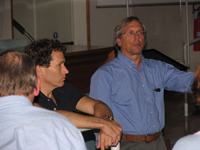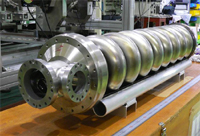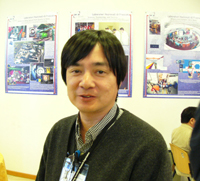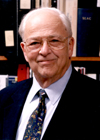 |
|
|
 |
Live from Frascati

Tor Raubenheimer (left) and Tom Markiewicz answering questions during yesterday's talk about the EDMS. |
On a hill overlooking the city of Rome, the GDE members arrived by the busload yesterday at INFN in Frascati, Italy. GDE Director Barry Barish opened the meeting by evaluating how much progress the 61-member organization has made during the past three months.
"Over all I think that we are doing quite well", he said. "In terms of where we wanted to be at the end of this year, we are in good shape. Our biggest problem, however, is communication. Having everyone distributed all around the world is very different than walking down the hall and talking to someone every day. We have a lot of gaps in communication. No matter how hard we try, we are not there yet."
In an attempt to improve communications between scientists, the GDE will start publishing the minutes of the Executive Committee meetings on the ILC Web site. "We are distributed, and that is a big handicap", Barish said. "We want everyone to be part of the process so that they know what is going on. We are trying our best, and we will learn."
In closing, Barish emphasized that the greatest strength behind the ILC is the science. "The science motivation for the ILC is our strongest weapon", he said. "The technical basis for the ILC is very strong, and we now have a vocal effort to do the design. We managed to converge these on a baseline. I think that once we take the words "strawman" off of this baseline, and finish the rough spots, we will be even more real and will be taken even more seriously."
Over the next two days, members of the GDE will discuss the Baseline Configuration Document in detail. All of yesterday's talks are available online. ILC NewsLine will include a full report on the meeting in next week's issue.
Photo page
--Elizabeth Clements
|
 |
|
|
 |
STF at KEK

TESLA-like 9 cell cavity will soon be tested in a
vertical cryostat for gradient performance. |
The KEK laboratory in Japan possesses a long history of building
and operating superconducting cavities, initiated in the TRISTAN days
of the 1980's and with the low energy ring at KEKB, which was built in the 1990s.
Most of these efforts, however, have been carried out in a context
that was substantially separated from the R&D for linear colliders,
because the focus of these efforts at KEK was on "warm" technology.
In August 2004, when ICFA announced its adoption of the "cold"
technology for the International Linear Collider, KEK faced a major
challenge to redirect all efforts, which to many felt like a sudden
90-degree turn.

Hitoshi Hayano |
Hitoshi Hayano was one of those who were confronted
by
this challenge, but he and his colleagues were fast to act. In less than
a few months after the ICFA decision, Hayano and the team drafted a
proposal to
build an integrated test facility called STF, Superconducting RF Test
Facility,
for testing the ILC components such as cavities, cryomodules,
cryogenics,
klystrons and modulators.
Read more
--Youhei Morita
|
 |
|
|
 |
Upcoming meetings, conferences, workshops
GDE Meeting
Frascati, Italy, 7-9 December 2005
American Linear Collider Physics Group - Detector Simulation Workshop
Boulder, Colorado, U.S.A., 9-11 January 2006
LCWS 2006
Bangalore, India, 9-13 March 2006
International Symposium on Detector Development in Particle and Astroparticle Physics and Synchrotron Radiation
SLAC, April 3-6, 2006
International School for Linear Colliders
Sokendai, Graduate School for Advanced Studies
Hayama, Japan, 19-27 May 2006
|
|
 |
 |
|
|
 |
Universities Test Prototype Detectors for an ILC Muon System

The first prototype plane with the 64-element multi-anode PMT (MAPMT) attached to it and the second prototype plane with no PMT attached to it. If you look closely you can see the green light from the 64 fibers coming out of the housing on the second prototype. (Image courtesy of Bob Abrams) |
A group of universities in the United States are currently testing prototype detectors that could be used for a muon system in the International Linear Collider. With the help of some high school students from Quarknet, an educational program that brings students and teachers into the laboratories, the University of Notre Dame completed two of the eight large rectangular planes that make up the prototype detector this past summer. These planes are now undergoing tests and collecting cosmic ray data at Fermilab.
Each rectangular plane is made up of 64 strips of plastic scintillator that are 4 cm wide and 1 cm thick. "Each scintillator strip has a groove cut down the middle that has a wave shifting fiber in it", said physicist Mitch Wayne of Notre Dame. "The muon goes through the scintillator, loses energy and a small amount of scintillation light is produced. Some of this light enters the wave shifting fiber and is converted to an optical wavelength -- green. This is then read out in a photodetector. If you see light, you know that a charged particle went through the strip."
Wayne emphasized that the contributions from the Quarknet students had a large impact on delivering the two planes to Fermilab on time. "We had three local high school students working on this project over the summer, and they had a great time", he said. "The Quarknet program is very careful to make sure that the students learn hands-on about particle physics during their internships at the laboratories."
Read more
--Elizabeth Clements
|
 |
|
|
 |
New Name and New Members: Linear Collider Steering Group of the Americas"
The former US Linear Collider Steering Group has changed its name to the Linear Collider Steering Group of the Americas, LCSGA, in recognition of the regional nature of particle physics in the Americas and as an expression of our desire to be as inclusive as possible.
We welcome two new members,Tor Raubenheimer and Harry Weerts and give our profound thanks to David Burke, Young-kee Kim and Jerome Friedman for service to the community as former members of the Steering Group.
The current Group membership is:
Jim Brau, U. Oregon
Sally Dawson, BNL
Johathan Dorfan, SLAC
Gerry Dugan, Cornell
George Gollin, U. Ill. at Urbana Champaign
Dean Karlen, U. Victoria
Harvey Lynch, SLAC - Executive Secretary
Shekhar Mishra, FNAL
Pier Oddone, FNAL
Mark Oreglia, U. Chicago
Satoshi Ozaki, BNL
Tor Raubenheimer, SLAC
Alan Schotter, TRIUMF
Maury Tigner, Cornell - Chair
Harry Weerts, ANL
--Maury Tigner
|
 |
|
|
 |
From Las Provincias
4 December 2005
Los físicos apuestan por colaboración entre grupos de trabajo nacionales y extranjeros
Físicos de todo el mundo han concluido que es necesaria una la colaboración entre países en materia de conocimientos físicos.
Read more
From Europa Press
2 December 2005
Innova.- Expertos internacionales se reúnen en Gandia para analizar el futuro colisionador lineal
Desde el 1 de diciembre, y hasta mañana sábado, se están celebrando en la Universitat Internacional de Gandia (Valencia) unas jornadas sobre el futuro colisionador lineal.
Read more
From Science
2 December 2005
Bullish on Particles
Particle physics was, until recently, the flagship of U.S. physics, if not U.S. science. With ever larger "atom smashers" and such charismatic figures as J. Robert Oppenheimer and Richard Feynman, the field attracted the best and the brightest.
Read more
From Europa Press
30 November 2005
Innova.- Expertos en física debaten en Gandia sobre el diseño y la tecnología del nuevo colisionador de partículas
Expertos internacionales en Física de Partículas debatirán desde mañana y hasta el día 3 de diciembre sobre el diseño y la tecnología del nuevo colisionador de partículas subatómicas en unas jornadas que se celebrarán en el Palacio Ducal de Gandía (Valencia), según informaron los organizadores.
Read more
|
|
 |
 |
|
|
 |
Frascati News
This week the GDE is in Frascati, Italy. We have come together for what is only our second face-to-face meeting, following our kick-off meeting as part of the Snowmass workshop just over three months ago. The main goal, finalizing the baseline configuration, represents the successful completion of a major milestone for the GDE. More than 100 physicists have come to Frascati for this specialized and task oriented meeting.
Our goals this week are rather specific. They are to finalize the baseline for the ILC in the form of our baseline configuration document (BCD), and to organize the overall GDE and ILC efforts for carrying out the reference design and global R&D programs next year.
The BCD is a tiered electronic document giving much of the details that will be needed as we move into the design phase. If printed, it comes to more than 600 pages, and it has been on the web in the form of a “strawman baseline” since mid-November. At that time, we invited input to the BCD on our website and have received a number of responses.

Burton Richter |
In addition, we also have gotten direct inputs on aspects of the BCD and have solicited and gotten some thoughtful inputs from three independent reviewers: Katsunobu Oide (KEK), Burton Richter (SLAC) and Lenny Rivkin (PSI).
In general, it is my assessment that, once the BCD goes through final iterations this week, it will form a strong basis for the ILC reference design effort next year. The next step will be to put the BCD under “configuration control.” This is a process that will make the BCD the official reference that will define the baseline configuration with the stability required to carry out a design and costing. Changes will be made in the configuration, but they will be proposed and approved through a formal process.
At the Frascati meeting, I am announcing a new organizational structure of the GDE for next year’s efforts. Briefly, the new organization is built around three GDE Boards that will guide and monitor the ILC R&D and the design/cost efforts.
--Barry Barish
Director's Corner Archive
|
 |
|
|
 |
Snowmass Proceedings
If you intend to submit papers from the Snowmass Workshop, please send an update to Norman Graf along with a firm estimate of the additional time requested.
Please recall that the length of working group reports should be limited to 30 pages.
Thank you for your prompt attention and your full cooperation in this joint effort.
International School for Linear Colliders
A curriculum is now available online for the International School for Linear Colliders. more information
ILC Related Preprints
hep-ph/0512084 - Reconstructing Supersymmetry at ILC/LHC 7 Dec 2005
physics/0512048 - Physics Options at the ILC. GG6 Summary at Snowmass2005 6 Dec 2005
hep-ph/0512053 - Top Quark Properties in Little Higgs Models 4 Dec 2005
hep-ph/0512028 - SUSY parameter determination 2 Dec 2005
hep-ph/0512022 - Virtual Corrections to Bremsstrahlung with Applications to Luminosity Processes and Radiative Return 2 Dec 2005
physics/0512004 - Particle Detector R&D 1 Dec 2005
hep-ph/0512020 - CPT violation in the top sector 1 Dec 2005
hep-ph/0512012 - Next Generation Multi-particle event generators for the MSSM 1 Dec 2005
hep-ph/0511344 - Supersymmetry Parameter Analysis: SPA Convention and Project 30 Nov 2005
hep-ph/0511335 - Distinguishing Between Models with Extra Gauge Bosons at the ILC 29 Nov 2005
hep-ph/0511332 - Toward High Precision Higgs-Boson Measurements at the International Linear e+e- Collider 29 Nov 2005
hep-ph/0511329 - Study of V_LV_L\to t\bar{t} at the ILC Including O(alpha_s) QCD Corrections 29 Nov 2005
physics/0510181 - CALICE Si/W electromagnetic calorimeter prototype, first testbeam results 19 Oct 2005
physics/0510085 - Spatial Resolution of a Micromegas-TPC Using the Charge Dispersion Signal 11 Oct 2005
|
|

